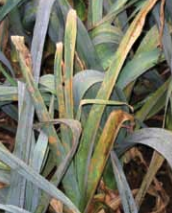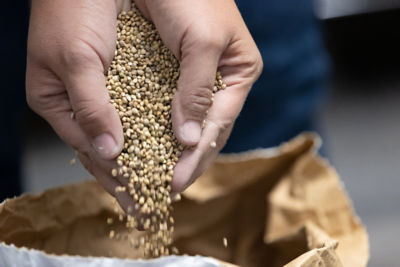Causal Agent
Puccinia allii (synonym: P. porri)
Distribution
Disease occurs worldwide in temperate and cool growing regions.
Symptoms
The disease first appears as small, circular, white to tan lesions along leaf veins. Lesions develop into orange to red circular or elongate uredial pustules that are often surrounded by chlorosis. Chlorotic leaf spots may also occur without further symptom development. When disease pressure is severe, leaves turn yellow and die prematurely. Dark brown teliospores may form in the pustules later in the season.
 Uredial pustules with surrounding chlorosis on leek.
Uredial pustules with surrounding chlorosis on leek.
 Foliar chlorosis and dieback in leek with severe Puccinia allii infection.
Foliar chlorosis and dieback in leek with severe Puccinia allii infection.
Conditions for Development
The fungus can survive as urediospores or teliospores. Wild Allium species serve as a source of inoculum from which urediospores are disseminated by wind over long distances. Infection is favored by cool to mild temperatures and high relative humidity (97 percent). Stressed plants are more severely affected by this disease than are healthy plants.
Control
Routine application of fungicides adequately controls this pathogen when disease pressure is low. Disease incidence is reduced by cultural practices such as crop rotation, low planting densities, destruction of wild Allium species and cultivation for good soil drainage. Where appropriate, isolation of leek from onion crops may also reduce disease.



